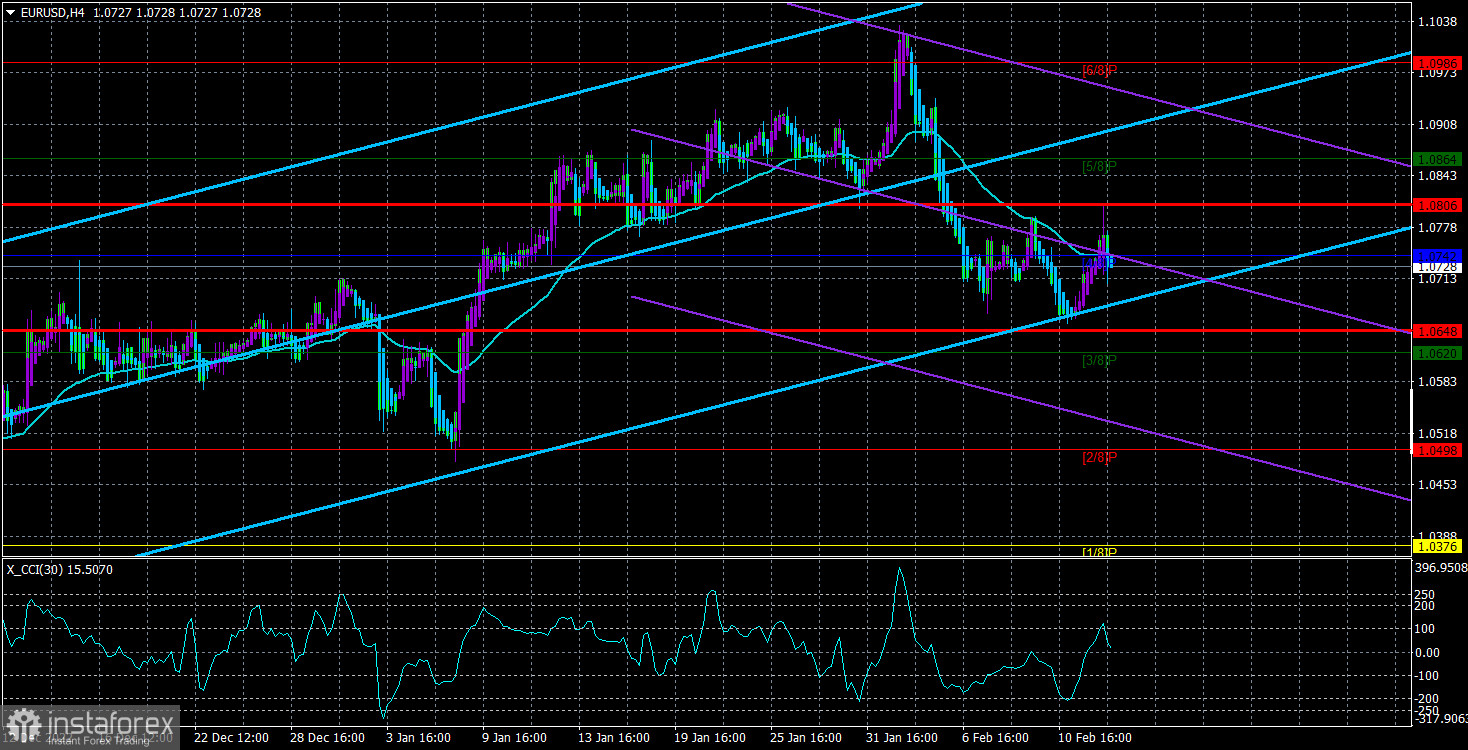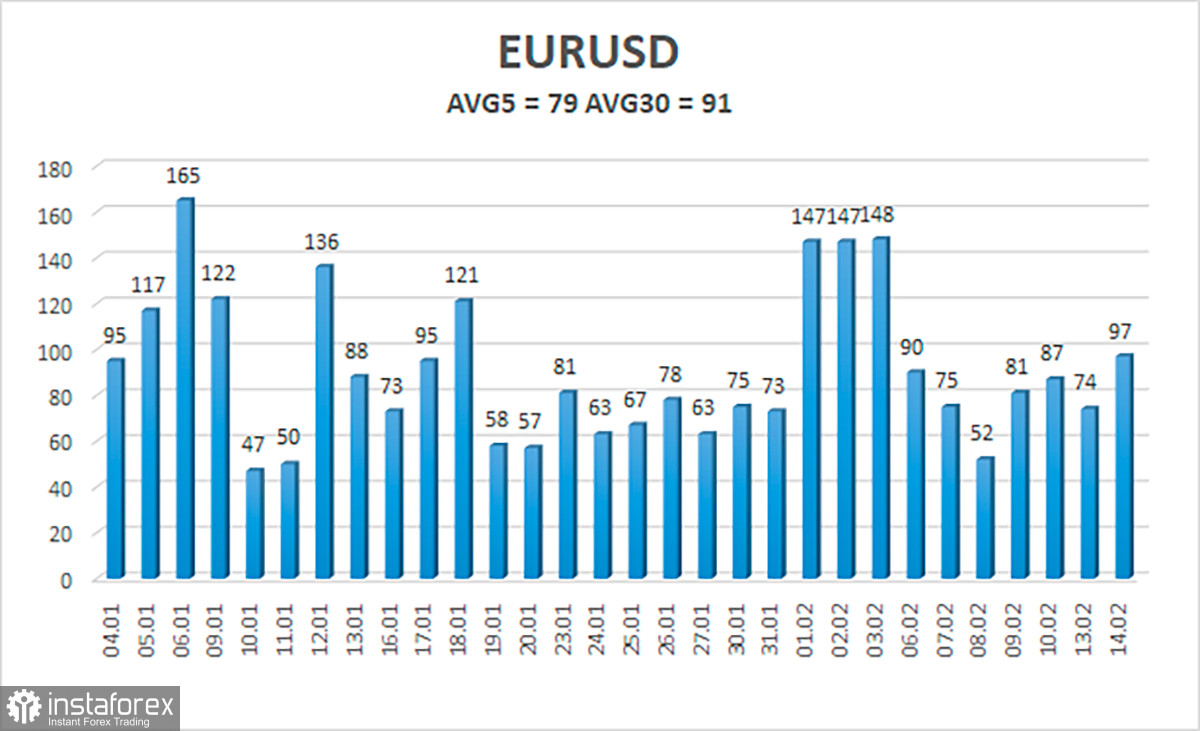
On Tuesday, the majority of the day's trading in the EUR/USD currency pair was calm. The current week's upward slope has continued, although so far it has the status of an ordinary upward pullback. Remember that despite the pair's significant decline over the previous two weeks, this decline still does not appear to be final in the medium term. The dollar will most likely start increasing again for this reason.
Naturally, there was only one significant event yesterday: the release of the American inflation report for January. The EU GDP report is important, but as of yesterday, we only had the second estimate for the fourth quarter. Investors were fully prepared for what to anticipate, and the report revealed a 0.1% increase in GDP. The third and fourth quarters of last year in America were quite successful, despite the first and second quarters being failures. As a result, speculation over a potential global recession has diminished. The scenario is reversed in the European Union, where the GDP indicator is steadily edging toward 0% in quarterly terms and is eventually likely to drop below this "waterline." A further increase in the ECB rate will inevitably result in a further decrease in the GDP indicator, even if the European Union appears to be able to avoid a severe and prolonged recession. Everything in this regard is therefore evident.
In America, everything is excellent, no matter where you look. If we exclude business activity indices and other secondary indicators, the labor market is in excellent shape, unemployment is low, and inflation has been falling for seven months in a row. Given that the Fed rate will likely be rising for some time, we think this is a great basis for further strengthening the US dollar. We shall see why in more detail below. We observe that the pair is currently attempting to cross the moving average line in the interim. We are anticipating either a resurgence or a more assured victory because fixing by 20 points for a 4-hour TF is not believable. We haven't reached the point where we'd say the trend is moving upward.
The rate of inflation fell by just 0.1%.
In January, the consumer price index decreased to 6.4%. Forecasts called for a drop of at least 6.2–6.3%. In line with expectations of 5.4-5.5%, the core inflation rate dropped to 5.6%. As a result, we must admit that the rate of deceleration is slowing. But some experts, like us, anticipated this. Inflation has started to fall practically everywhere in recent months. This shows that some outside factors may have contributed to the decrease in price growth. The cost of oil and gas is unquestionably one of these factors. Prices have drastically fallen in recent months, even though they were generally rising for the majority of last year, and just broke all records for gas (for gas, by more than three times). As a result, prices for products and services started to drop worldwide, as well as the growth rate. The consumer price index has decreased rather much as a result of this and the Fed's active monetary policy, but eventually, everything comes to an end. The price of oil and gas has stopped falling, and the Fed has already scaled back its plan to raise the key rate twice. It made sense to believe that when inflation fell, it would also start to slow down. The only remaining issue is how the Fed will respond now that it has occurred.
It makes sense that the regulator would respond by adopting a new "hawkish" attitude, which would signal to traders that the regulator is prepared to take any action necessary to tame the rapid rate of price growth. The dollar will have new reasons to increase if this occurs. This might cause the US dollar to rise significantly due to the overbought euro and the necessity for the pair to continue adjusting down. Furthermore, we think that the Fed must respond to this study. If its officials have been continually talking about the need to tighten for a long time, now is the time for such words to be especially applicable.

As of February 15, the euro/dollar currency pair's average volatility over the previous five trading days was 79 points, which is considered "normal." So, on Wednesday, we anticipate the pair to move between 1.0648 and 1.0806 levels. The Heiken Ashi indicator's downward turn will signal a potential continuation of the downward movement.
Nearest levels of support
S1 – 1.0620
S2 – 1.0498
S3 – 1.0376
Nearest levels of resistance
R1 – 1.0742
R2 – 1.0864
R3 – 1.0986
Trading Suggestions:
The EUR/USD pair continues the downward trend. When the Heiken Ashi signal reverses downward and the price is below the moving average, it may be appropriate to think about opening new short positions with targets of 1.0659 and 1.0620. After the price is fixed above the moving average line, long positions can be initiated with targets of 1.0806 and 1.0864.
Explanations for the illustrations:
Determine the present trend with the use of linear regression channels. The trend is now strong if they are both moving in the same direction.
Moving average line (settings 20.0, smoothed): This indicator identifies the current short-term trend and the trading direction.
Murray levels serve as the starting point for adjustments and movements.
Based on current volatility indicators, volatility levels (red lines) represent the expected price channel in which the pair will trade the following day.
A trend reversal in the opposite direction is imminent when the CCI indicator crosses into the overbought (above +250) or oversold (below -250) zones.





















